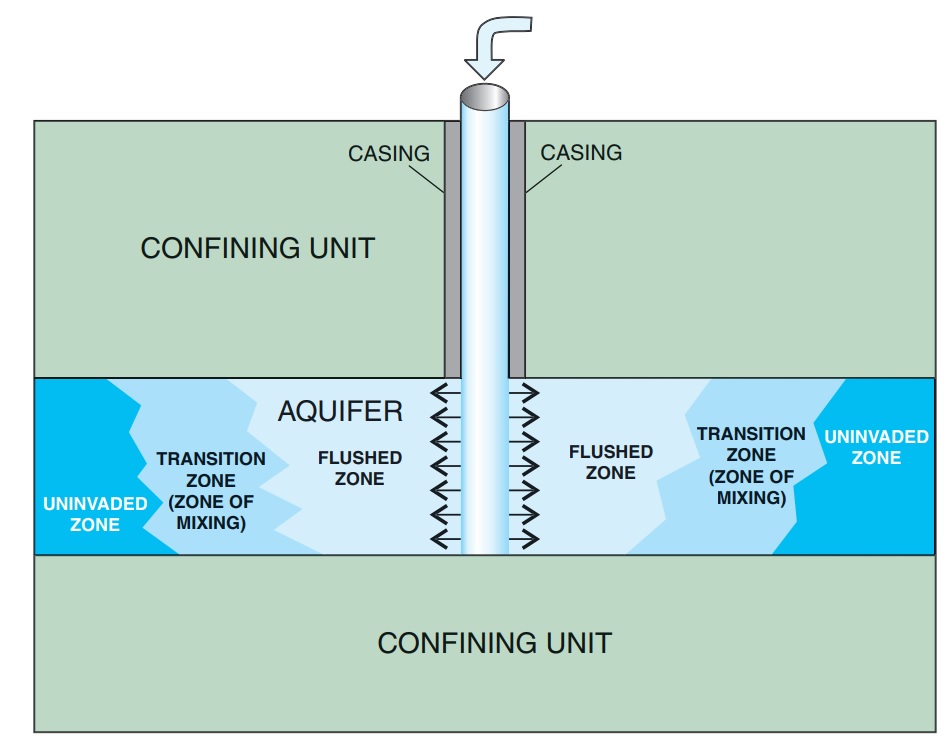The INOWAS platform provides tools for the assessment of the resulting recovery efficiency when applying MAR.
The feasibility and cost effectiveness of a prospective MAR project needs to be evaluated meticulously. One key parameter which influences the success or failure of a MAR facility is the recovery efficiency. It is defined as the volume of water that can be recovered with desired water quality divided by the volume of injected water (Maliva, 2006). The desired water quality of the recovered water depends on the later use e.g. for irrigation or as tap water. Often the concentration of chloride or total dissolved solids (TDS) are considered as limiting factors for water quality of the recovered water. Parameters influencing recovery efficiency include hydrogeological and operational parameters. Operational parameters include e.g. the volume, quality and rate of injected water, the storage duration and cycle numbers. Hydrogeological paramaters which influence recovery efficiency encompass e.g. the local groundwater gradient, aquifer hydraulic conductivity, groundwater quality (especially salinity), aquifer storage coefficients but also the aquifer heterogeneity. These parameters define which and to what extent local processes in the aquifer occur. Processes which are relevant for the resulting recovery efficiency include advection, dispersion, mixing as well as geochemical reactions between injected and local groundwater and fluid-rock interactions. Typically the recovery efficiency increases with repeated cycles as part of the water from previous cycles is left in the aquifer and mixes with the newly recharged water.

Figure 1. Aquifer storage and recovery (ASR) well in a confined aquifer showing idealized flushed and transition zones created by recharge (Reese, 2004). The flushed zone contains mostly recharged water. Part of the recharged water is not recovered and therefore recovery efficiency is typically increasing with the number of cycles.
The INOWAS platform offers tools to analyse and predict the resulting recovery efficiency when injecting surplus water into an aquifer. Especially for Aquifer Storage and Reocvery (ASR) or Aquifer Storage, Transfer and Recovery (ASTR) systems, the success of the system is evaluated by considering the recovery efficiency and simulated by applying numerical models. Groundwater flow and solute transport models were widely used to examine the influence of hydrogeological and operational parameters on the recovery efficiency (Brown, 2005; Lowry and Anderson, 2006; Maliva et al., 2006). In one of the earliest studies by Merritt (1986) a three-dimensional finite difference saturated flow and solute transport model was applied to estimate the sensitivity of the recovery efficiency of ASR wells to a range of hydrogeological parameters in Florida, USA. A key parameter that influences the recovery rate is the dispersity of the aquifer which controls mixing between injected and ambient groundwater (Lowry and Anderson, 2006; Pavelic and Dillon, 2002; Ward et al., 2009). When infiltrating into brackish or saline aquifers, density-driven and buoyancy-induced flow must be taken into account (Guo et al., 2015; Maliva et al., 2006; Miotliński et al., 2014; Ward et al., 2009; Zuurbier et al., 2015). The aquifer heterogeneity has also a distinct impact on the shape of the injected freshwater bubble in brackish storage zones (Maliva et al., 2006; Vacher et al., 2006). A simple screening tool developed by Ward et al., 2009 can help to assess ASR performance in brackish and saline aquifers prior to numerical modeling.
The following INOWAS tools can be used to assess the recovery efficiency at MAR facilities:
To select a suitable MAR method or a model set for the specific study area, the following tools can be used:
REFERENCES
- Brown, C.J., 2005. Planning Decision Framework for Brackish Water Aquifer, Storage and Recovery (ASR) Projects (Dissertation). University of Florida.
- Guo, W., Coulibaly, K., Maliva, R.G., 2015. Simulated effects of aquifer heterogeneity on ASR system performance. Environmental Earth Sciences 73, 7803–7809. doi:10.1007/s12665-014-3822-4
- Lowry, C.S., Anderson, M.P., 2006. An Assessment of Aquifer Storage Recovery Using Ground Water Flow Models. Ground Water 44, 661–667. doi:10.1111/j.1745-6584.2006.00237.x
- Maliva, R.G., Guo, W., Missimer, T.M., 2006. Aquifer Storage and Recovery: Recent Hydrogeological Advances and System Performance. Water Environment Research 78, 2428–2435. doi:10.2175/106143006X123102
- Merritt, M.L., 1986. Recovering Fresh Water Stored in Saline Limestone Aquifers. Ground Water 24, 516–529. doi:10.1111/j.1745-6584.1986.tb01031.x
- Miotliński, K., Dillon, P.J., Pavelic, P., Barry, K., Kremer, S., 2014. Recovery of Injected Freshwater from a Brackish Aquifer with a Multiwell System. Groundwater 52, 495–502. doi:10.1111/gwat.12089
- Pavelic, P., Dillon, P.J., 2002. Lumped parameter estimation of initial recovery efficiency during aquifer storage and recovery, in: Management of Aquifer Recharge for Sustainability: Proceedings of the 4th International Symposium on Artificial Recharge of Groundwater. ISAR-4, Adelaide, South Australia, 22-26 September 2002. A.A. Balkema, Lisse, pp. 285–290.
- Reese, 2004. Review of Aquifer Storage and Recovery in the Floridan Aquifer System of Southern Florida. USGS Fact Sheet, https://pubs.usgs.gov/fs/2004/3128/pdf/fs-2004-3128-Reese.pdf, 25.07.2019.
- Vacher, H.L., Hutchings, W.C., Budd, D.A., 2006. Metaphors and Models: The ASR Bubble in the Floridan Aquifer. Ground Water 44, 144–154. doi:10.1111/j.1745-6584.2005.00114.x
- Ward, J.D., Simmons, C.T., Dillon, P.J., Pavelic, P., 2009. Integrated assessment of lateral flow, density effects and dispersion in aquifer storage and recovery. Journal of Hydrology 370, 83–99. doi:10.1016/j.jhydrol.2009.02.055
- Zuurbier, K.G., Kooiman, J.W., Groen, M.M.A., Maas, B., Stuyfzand, P.J., 2015. Enabling Successful Aquifer Storage and Recovery of Freshwater Using Horizontal Directional Drilled Wells in Coastal Aquifers. Journal of Hydrologic Engineering 20, B4014003. doi:10.1061/(ASCE)HE.1943-5584.0000990
